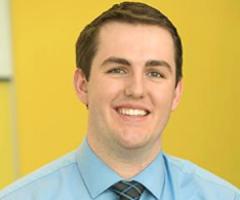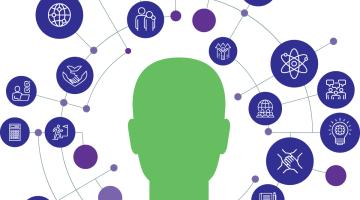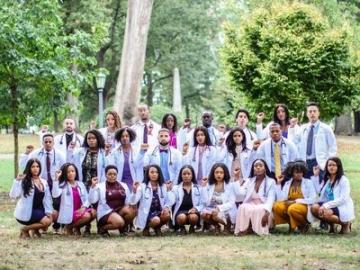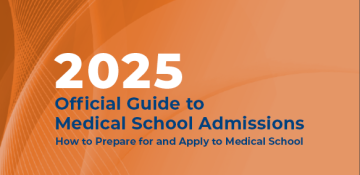New section
“Challenges and setbacks are inevitable, and these are the moments that force us to grow. Reflect on these moments when they have passed and understand perfection is not the expectation. Work hard given the situation that you're in and be the best you can for those around you."

- Medical School: The University of Michigan Medical School.
- Expected Graduation Year: MD/MBA, 2022.
- College & Major: Northern Arizona University, biomedical sciences.
Editor’s Note: The opinions expressed in this article are those of the author and do not necessarily reflect the opinions, positions, or the polices of the AAMC or its members.
New section
Background
- First-generation college graduate.
- Grew up in rural Montana and desires to return to serve his community.
- Career aspirations shifted from athletic training to medicine once he concluded he’d have more independence and could make a significant impact on Montana residents as a physician.
- Lack of prehealth advisor led to him identifying several mentors to coach him through the process.
- Utilized skills gained from playing college football to adapt to the rigors of medical school.
MCAT® Score/GPA/Coursework
It wasn’t the required coursework, GPA, or MCAT® exam that concerned Bridger, but the worry that medical schools’ admissions officers would perceive his undergraduate education as less rigorous or prestigious because he didn’t attend a more well known, larger institution. Contrary to his belief, his decision to attend Northern Arizona University (NAU) worked in his favor. “Bridger went to a smaller, public university in Arizona, which I believe aided his transition to college,” said Jody Kosanke, retired Recruitment/Retention Specialist, Senior & Learning Specialist for the University of Arizona College of Medicine.
Bridger began building academic stamina before starting at NAU. While his completion of community college classes at the same time of his participation in an NAU football summer training camp was impressive, his accomplishments at NAU were what really stood out to application reviewers. “We haven't had many students from his undergraduate institution, but his stellar grades and MCAT score showed that he was ready for the challenge of medical school,” said Carol Teener, Director of Admissions at the University of Michigan Medical School (UMMS).
To prepare for the level of difficulty that medical school would present, Bridger took courses on infectious diseases, evolutionary medicine, medical gross anatomy, and medical human physiology during his final year at NAU. Bridger’s MCAT preparation was highly unique due to competing demands between his extracurricular commitments. He studied for over a year to build up his knowledge base for the MCAT exam. During the academic year and while preparing for the MCAT exam, Bridger’s schedule was jam-packed with athletics-related activities, courses, research, and studying from 6 a.m. to 10 p.m. each day.
“That year was filled with a lot of long nights, but it was necessary to achieve my academic and athletic goals. I can’t tell you how many times I had people tell me, ‘You should just switch majors and do something else,’” said Bridger.
Experiences
Some of the challenges Bridger faced became the key ingredients for his preparation for a career in medicine. “He faced many disparities; [he was a] first-generation college student, coming from a rural, underserved area in Montana; [he experienced a] lack of resources, low socioeconomic status, and [was] uninsured for part of his life,” Ms. Kosanke said. His upbringing strengthened his ability to empathize with patients living in rural Montana communities and gave him the desire to return home to serve them.
“Not many people from rural backgrounds are able to pursue an education, and of those that do, very few will pursue a graduate or professional degree. Coming from a rural background has given me a unique perspective on how to be mindful of geographic and financial barriers to health care for patients from rural backgrounds,” Bridger noted.
An unexpected obstacle that Bridger still navigates today is how his time as a collegiate football player shapes other peoples’ opinion about him becoming a competent physician. Bridger stated, “I think there are people who stereotype college football players, both inside admissions committees and in society at large. For every person who would admire a football player pursuing medicine, there are certainly others who have instant judgments about this. Even since enrolling in medical school, I have received [negative] statements and remarks.”
Ultimately, he recognized that not everyone held the same views, and that it was necessary to highlight his athletic experience in his application. Bridger said, “The transferrable skills that come from being a collegiate student athlete — discipline, time-management, and perseverance — made a compelling argument that I could become a great medical student. ‘Coachability,’ the ability to respond quickly and effectively to feedback, communication, ability to work within diverse teams, and a strong work ethic don't always come standard. However, athletes have these skills refined and ready to go prior to the start of medical school.”
Showcasing his multitude of valuable skills and experiences, including those he acquired from playing football, was something Bridger focused on in his application. As an undergraduate, Bridger started NAU’s American Medical Student Association chapter, taking responsibility to advocate for funds and resources when they weren’t readily available. Bridger also studied the effect of age on transcription factor migration in response to an acute exercise stimulus. However, earning the opportunity to work on this project was no easy task. He started by cold-emailing various faculty on campus; meanwhile, he identified the Student Undergraduate Research Council, which advocates for undergraduate students to get research experiences, to help him find a suitable research project. Eventually, he found an opportunity in a basic science lab, but the lab closed shortly thereafter when the lead scientist left the university. Before the scientist left, Bridger requested assistance finding another lab on campus. He eventually landed in Dr. Traustadóttir’s exercise and aging lab. After becoming familiar with the lab, he took on a three-credit, independent research project that required the development of a novel solution for measuring the results and showcasing the cellular processes taking place.
The research goals were to determine how certain transcription factors migrated as a result of exercise and if age played a factor in the cell signaling processes. This required additional international collaborators from biotech, microbiology, and redox biology; this also required laboratory equipment not available at NAU. With the help of these colleagues, he needed to learn immunofluorescent microscopy and find ways to use antibodies conjugated with fluorescent dyes to count protein translocation in response to exercise. However, there were no previous studies that he could directly draw from to aid his research. This required Bridger to take on novel aspects of research, such as acquiring funding, recruiting participants, developing a method to label the proteins properly, and creating an effective, long-term storage method for the cell.
For admissions committees, showing the initiative in identifying and pursuing opportunities like this, as well as tackle these types of responsibilities, serves as a great example of an applicant who could respond to the medical school environment. Bridger continued to work in his research lab for an additional four semesters, for which he did not receive credit or compensation outside of the completion of his three-credit independent research course.
“When candidates like Bridger dedicate themselves to months and years of work in the clinical research and volunteer realms, it shows that they have a maturity in how they reflect on why they did what they did and what they learned about themselves,” Ms. Teener said.
Personal Statement
Although Bridger now feels that his personal statement was the most substantial part of his application, he had to work to become comfortable with sharing his story. Ms. Kosanke, whom he met at a career fair at NAU, took on the role of his unofficial advisor. Despite a distance of 300 miles between them, she began mentoring Bridger because his institution had minimal prehealth advising resources. They frequently spoke on the phone and sometimes met in person in Tucson to work together.
Their conversations covered topics such as study skills for the MCAT, interview preparation, applying for the Fee Assistance Program, and preparing his personal statement. Ms. Kosanke said, “He is very humble and didn’t want to talk about his underserved upbringing. I assured him that it was a vital part of his application.”
After many sessions together, Bridger produced a personal statement that he felt reflected his journey. He said, “I really felt like it demonstrated how my past shaped my commitment to pursuing this path to the fullest.”
Bridger shared two excerpts from his personal statement:
“At first, I was largely unsure about being a doctor. I shadowed my physician mentor and observed how he orchestrated an entire practice. This allowed me to gain a multitude of hours in clinical experience and direct patient care, often filled with challenging situations, diverse patient backgrounds, and demands. After a few months into my clinical rotation with him, I was due for a performance review discussing my strengths and weaknesses as a student volunteer of his. This review could be summed up with his one declaration: ‘You would be selling yourself short stopping at Athletic Training.’ This statement stunned me. Nobody in my family has ever graduated from college, let alone became a doctor. Why would I be any different?
From the time I was released from the hospital, I relied heavily on those around me for support, most importantly my surgeon. More than anyone else, his care and understanding of what I was enduring mentally made the biggest difference of all. His knowledge was empowering and made me feel like there was nothing in the way of my return to the football field. During those moments of weakness, he lifted me back up and reminded me of the strength that was building inside of me because of this injury. To give that kind of power and confidence to a person is indescribable and is what I strive to give to those around me.”
Letters of Evaluation
Bridger turned lemons into lemonade, developing supplemental advisor-like relationships with people in various roles to help him on his journey to medicine. Although he didn’t have an official prehealth advisor, he formed relationships with upperclassmen and graduate students on the premed track, as well as his research mentor, Dr. Tinna Traustadóttir (in addition to Ms. Kosanke). When it came down to selecting his letter of evaluation writers, he chose individuals like Dr. Traustadóttir, who had the most knowledge of his skills, abilities, and experiences. This included his former organic chemistry professor, with whom he later worked for as a teaching assistant, and two orthopedic surgeons that he shadowed in high school and college, respectively.
Bridger attributes much of his preparation for medical school to his time with these two surgeons who allowed him to routinely shadow them in the operating room, observe orthopedic conditions in clinic and even scrub in on a few cases. Being able to gain this experience in rural, underserved areas was an additional advantage.
Bridger met Dr. Weinstein, the surgeon he would eventually shadow in high school, when he was his patient. He expressed interest in Dr. Weinstein’s work after his follow-up appointments concluded. Before his senior year of high school, Bridger worked with his high school’s athletic trainer to create a new course that allowed students to gain hands-on, clinical experiences while developing a research-based capstone paper. It took a great deal of persistence and support from the high school's administration, but the course was eventually approved, leading the inaugural class to significant success. To date, the course has been adopted by multiple school districts.
Later, Bridger met Dr. John Flint, the orthopedic surgeon he shadowed in college, at a career fair hosted by NAU. A lengthy discussion during the event prompted Bridger to follow up with Dr. Flint via email, which evolved into a structured volunteer position at his hospital.
“For premeds in rural areas, it’s extremely important to find a physician or surgeon who is excited about teaching and willing to include you in day-to-day tasks. As a student, it’s important to find a role within the clinic or operating room,” said Bridger.
In addition to letters that represented his medically related experiences, he also asked his athletic trainers, strength coaches, and volunteer coordinators to write a letter in support of his application to medical school. They had witnessed his resilience and determination as he recovered from a knee injury that had forced him to relearn how to walk, run, and jump again.
“Bridger had amazing letters of evaluation from people who knew him well. We encourage applicants to send letter writers the AAMC Guidelines for Writing a Letter of Evaluation for a Medical School Applicant to assist in writing about applicants' competencies. Bridger’s letter writers described the activities in which they felt he demonstrated resilience and adaptability, formed excellent communication skills, and shaped his identity around a strong sense of teamwork and community. They gave examples of him taking the initiative in starting programs to help those around him and being a natural, effective communicator, speaking with his peers honestly,” Ms. Teener said.
Interview
Resources to prepare for medical school interviews were not readily available to Bridger, but he did not let that deter him. He created a strategy to get the practice he needed, including traveling to in-person medical school events at the University of Arizona-Tucson and utilizing online interview guides provided by medical schools and other forums. He used the University of Colorado’s online list of sample questions to properly frame his answers about his background and prior experiences in the rural healthcare system. He also asked Ms. Kosanke for help in preparing for traditional and Multiple Mini Interviews. He spent his time preparing for the interviews by reviewing ethics guidelines, healthcare policy, health care administration issues, and current events, which he was ultimately questioned on.
His hard work paid off; the interviewers were impressed with what Bridger was able to demonstrate. Ms. Teener said, “The interviewers were immediately able to tell that Bridger was motivated to have a career in sports medicine, that he was extroverted and outgoing, and that he was someone who placed great emphasis on his community. His interviewers stated that they would be glad to have him as a student, resident, or colleague, and were so appreciative of his industry, practicality, and collegiality.”
Bridger commented, “While no interview is the same as another, the purpose of an interview is to confirm that you are a great fit for the institution and that you should be highly considered for admission. Each school does it differently, but they all have the same basic characteristics they are looking for in their candidates: respect for others, critical thinking, altruism, teamwork, communication, and a desire to learn.”
Bridger on Why He Chose the University of Michigan Medical School
Bridger chose UMMS because of the connection he drew between their culture of excellence and the level of excellence expected during his time spent playing football. “As a football player, it was common to hear ‘iron sharpens iron,’ and I strongly believe this applies to medicine and life as a whole. Much of who we are and what we become is a product of our environment,” he said.
Bridger also felt very comfortable during his interview process at UMMS.
“UMMS had the most comprehensive and transparent interview process of all the schools I interviewed with. They were clear about what they were hoping to gain from the interviews (mutual evaluation of fit for the program) and were very open about the interview format. The interviewers created a professional and kind atmosphere for Interview Day; they actively advocated for me to ask questions and get multiple perspectives on life as a medical student,” said Bridger.
Bridger is currently pursuing a dual degree through an MD-MBA program to further his skillset and create effective change in health care access and delivery in Montana.
“Learning to speak the language of business and administration will not only benefit the care that I am able to deliver, but also allow me to advocate for effective changes that benefit all patients who receive care. I wanted to further my leadership skills, learn how to be a better teammate for those around me and implement methods of constructing better teams within medicine. There's nothing more frustrating than a team that doesn't work well together or a system that doesn't allow for teams to be effective,” he said.
The University of Michigan Medical School Admissions Team on Why They Chose Bridger
When evaluating whether Bridger would be a good fit for Michigan’s program, Ms. Teener said that what Bridger demonstrated in his application materials epitomized a teammate who desired to help others for the greater good.
Steven Gay, MD, MS, Assistant Dean for Admissions and Associate Professor of Internal Medicine at UMMS, weighed in about Bridger’s qualities and agreed that his teamwork mentality, which was nurtured during his football career, has proven to be a key asset in medical school. “His experiences as an athlete have taught him that the end result has more impact and is more transformative when everyone’s contributions mesh together to succeed toward a singular goal. Bridger relishes the competition that makes us better, in light of competing as a team toward a goal,” Dr. Gay said.
The admissions team also valued Bridger’s rural upbringing and ability to share his perspective on geographical disparities, as well as his passion for clinical research and collaboration.
New section
Highlighted Competencies
Note: This section helps to illustrate how multiple competencies can be demonstrated across many experiences, activities, and parts of your application.
Shows a commitment to something larger than oneself; demonstrates dedication to service and a commitment to making meaningful contributions that meet the needs of communities.
Started a medical student association and took lead on advocating for funds and resources when unavailable.
Built strong relationships with doctors, professors, research stakeholders, volunteer coordinators, coaching staff and teammates.
Appreciates how historical, sociocultural, political, and economic factors affect others’ interactions, behaviors, and well-being; values diversity; and demonstrates a desire to learn about different cultures, beliefs, and values.
Empathized with under-resourced patients in rural communities; expressed desire to work in rural areas; demonstrated motivation to create effective change in health care access and delivery in Montana.
Collegiate student athlete; worked collaboratively with internal and external stakeholders on three-credit research project; demonstrated competence as an effective and natural communicator when starting programs to help peers.
Demonstrates accountability for performance and responsibilities to self and others; prioritizes and fulfills obligations in a timely and satisfactory manner; and understands consequences of not fulfilling one’s responsibilities to self and others.
Balanced athletic training, courses, volunteering in a research lab, shadowing, and studying for the MCAT exam.
Pursued medical education despite his family never pursuing a post-secondary education and coming from a rural background; found opportunities to work on research projects and took on novel aspects of research; persevered through serious injury.
Practices continuous personal and professional growth for improvement, including setting and communicating goals for learning and development; reflects on successes, challenges, and mistakes; pursues opportunities to improve knowledge and understanding; and asks for and incorporates feedback to learn and grow.
Volunteered time to work in a research lab for an additional four semesters after completing three-credit project; proactively sought and implemented guidance from mentors.
Uses logic and reasoning to identify the strengths and weaknesses of alternative solutions, conclusions, or approaches to problems.
Research experience, shadowing, coursework.
Applies quantitative reasoning and appropriate mathematics to describe or explain phenomena in the natural world.
Research experience, coursework.
Applies knowledge of the scientific process to integrate and synthesize information, solve problems, and formulate research questions and hypotheses; is facile in the language of the sciences and uses it to participate in the discourse of science and explain how scientific knowledge is discovered and validated.
Coursework, continued involvement and work in the research lab, shadowing surgeons.
Effectively conveys information to others by using written words and sentences.
Personal statement, writing related to research.


